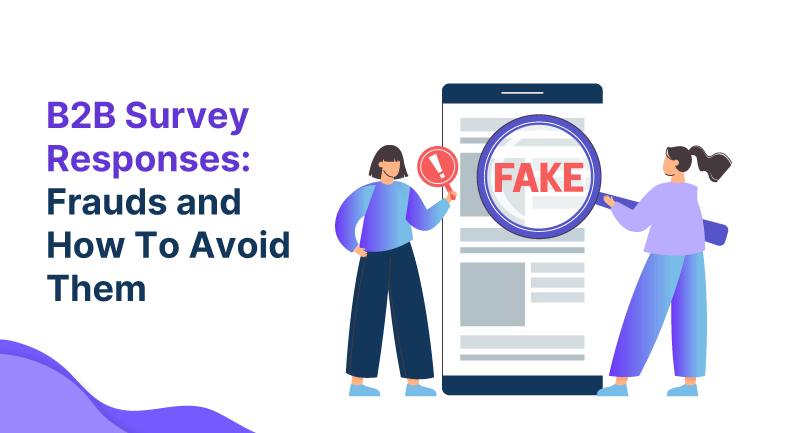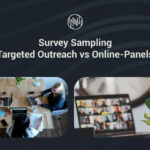
Survey fraud is not a new evil, but for b2b research, the consequences are much greater. While consumer research has a large enough dataset such that a couple of hundred fraudulent responses might be diluted out, b2b surveys have small, specialized groups being researched. A few bad responses can skew results such that million-dollar decisions directly suffer. As you conduct a b2b customer satisfaction survey, a b2b expert survey, or a b2b marketing survey, data quality protection against fraud is no longer a luxury. It is a necessity.
The Risk: How B2B Fraud Hurts More
B2B survey studies typically have executives, specialty technical specialists, or industry decision-makers as targets. That makes each respondent worth that much more. If just 10% of your sample is fraudulent, the harm to insight is extreme: a false Net Promoter Score, inaccurate account-level information, or flawed segmentation that ruins marketing programs. As with consumer studies, you can’t just replace bad information by taking more from a large pool. Once the sample is corrupted, credibility takes a hit, so does confidence in recommendations.
Types of B2B Survey Scams
Fraud takes many forms in digital surveys, and B2B is especially vulnerable. Some fraudsters use bots or automated scripts to rush through questions and claim incentives. Others are professional “reward hunters” who disguise their identity and attempt to qualify multiple times. A common tactic is misrepresenting firmographics, pretending to be a manager at a certain company or in a specific role when in fact the respondent has no such background. Speeding, straight-lining, and copy-pasting nonsense text are red flags you often see during fielding. In global studies, location masking via VPNs can also flood surveys with responses that appear to come from the target market but do not. Each of these behaviors erodes confidence in the final dataset.
Pre-Field Controls: Catching Fraudsters at the Gate
Fraud prevention starts even prior to the launch of the survey. Best protection is managing how respondents are invited. Single-use tokens and invite-only links make certain that no one other than the target participants have a way into the survey. Screening questions should not only filter but confirm. A request for a corporate e-mail address or a certain industry nuance that a genuine professional alone might be familiar with makes spurious entries less likely. Payment design also plays a role. Fraud loves instant and transferrable incentives. Delays or conditions on incentives, released only after quality assurance, deter opportunists from committing fraud. For a b2b expert survey or a b2b customer satisfaction survey, respondents are frequently high-earning specialists, for whom extra screening via CV verification or LinkedIn authentication is the norm. For a b2b customer satisfaction survey, for which there are likely lists of accounts, drawing directly from authenticated customer databases keeps exposure at a minimum.
In-Field Detection: Catching Red Flags While Running
Once you have the survey live, real-time tracking of responses matters. Time of completion is one of the strongest signals. If the median time for a 15-minute survey is 15 minutes, and a respondent finishes it in five, then that answer is probably invalid. Straight-lining, or answering the same way repeatedly across a set of questions, is another, and repeated or nonsensical writing across open-ended questions is yet another. Device and IP fingerprinting, for identifying repeat respondents using a form of advanced tracking, and geo-location verification, for confirming that the answer is coming from the correct market, are more sophisticated techniques yet again. Attention checking needs to be carefully constructed so it is subtle enough not to irritate honest participants yet effective enough for the dropout of invalid respondents. Done in combination, you eliminate a lot of invalid data at a source rather than allowing it to accumulate.
Post-Field Validation: Validation for What Remains
Even with rigorous pre-field and in-field controls, post-field validation is a necessity. This step includes checking the dataset for outliers, triangulating responses, and examining suspicious cases manually. Statistical methods like cluster analysis assist in recognizing respondents whose responses stray significantly from the norm. For high-risk b2b marketing survey projects, cross-validating survey assertions with outside data, such as validating a tech purchase from billing files or a follow-up of a sample of respondents telephonically, is an added measure of surety. Open-text responses should invariably be Googled for repeated terms or patterns indicating bot responses. The ultimate dataset should be one your team feels no hesitation defending in front of executives.
Supplier and Purchasing Verification
When utilizing third-party panels or study providers, protection against fraud should be included in procurement discussions. Ask for disclosure of what processes they have for attesting respondents, what percentage of responses they automatically reject on a routine basis, and what technologies they have for identifying fraudulent activity. Providers should be willing to show you scrub logs, audit trails, and sample origins. A decent vendor should also have defined policies for replacing or refunding fraudulent responses. Defining these requirements within agreements helps hold individuals responsible.
Transforming Controls into Practice
Fraud prevention can feel abstract until it is operationalized. In practice, you need a playbook that can be applied project by project. That means hardening your screeners so only real professionals pass, reviewing vendor QA reports before accepting data, setting up alerts for suspicious completion times, and manually auditing a small percentage of open-text responses. These are not complex measures, but they require discipline. A single overlooked control can allow dozens of bad responses to slip through.
Measuring Fraud and Learning from It
Like any other quality process, fraud prevention should be measured. Keep track of the percentage of responses flagged and removed, the common reasons for rejection, and the time it takes to clean data after fielding. If you see patterns, for example, higher fraud in certain geographies or project types, you can adjust sourcing and design accordingly. Over time, this creates a feedback loop that strengthens your defenses and gives stakeholders confidence in the insights delivered.
Final Thoughts
B2B survey research presents singular value but singular risk as well. Deceptive responses are more than noise. They have a way of changing results that harm strategy and squander budgets. Through a combination of pre-field controls, in-field supervision, and post-field verification, you safeguard the integrity of your information. The added effort guarantees that your b2b customer satisfaction survey, your b2b expert survey, or your b2b marketing survey produces results that are defensible, actionable, and worth the decisions they inform.









